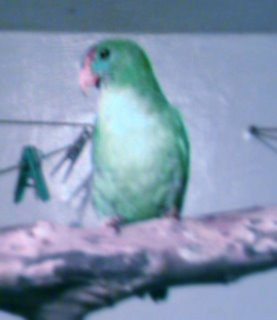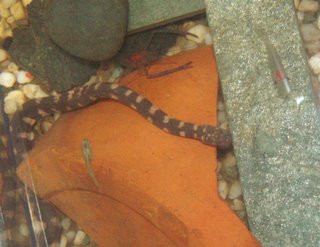Chinese Fire Bellied Newts
Newts are wonderful. Easy to keep, fun to watch and with a brain somewhat bigger than a scorpion’s, they make very interesting pets. Personally, I have two and you’d be surprised how different their characters are.
Housing: Water quality is very important for news, salamanders, and just about any other amphibian. Ideally, you’d keep them in a large aquarium with several liters of water and a strong but safe pump. That’s the ideal situation. Strong pumps I’ve got, safe ones I haven’t. Therefore, instead of a pump, I use guppies and a small freshwater shrimp. Between them they seem to keep the water at a decent level. Besides, I think the aquarium plants absorb some of the Nitrogenous waste.
I keep my (fully aquatic) newts in a 15gallon aquarium that is about 2/3 filled with water. Their aquarium must… and that’s worth repeating… must have a lid that stops your pets climbing up the sides and escaping. My aquarium is basically divided in two parts. One part has a mound or (large) gravel that is almost as high as the water is deep. The rest is pretty much empty swimming space, except for a few aquarium plants in one corner to provide entertainment and hiding spaces. I also keep a semi-submerged branch for the newts to ‘bask’ on. These newts seem to prefer cooler conditions, so don’t heat their aquariums to tropical levels. Change their water regularly – about once every week, more often if possible (obviously don’t give them a temperature shock – only change a small amount of water at a time).
Feeding: I feed my newts a staple of live bloodworms. I occasionally give them a small mealworm and I’m sure they nab the occasional baby guppy. I just hold the mealworms close to the newts using a thin pair of tweezers (make sure the newt can hurt itself if it accidentally grabs the tweezers instead of the worms). Once the newts see the blood worms wriggling they will lunge at them and such them into their mouths. A word of warning: guppies can make it insanely difficult to do this. Adding guppies helps with water quality and provides an occasional snack, but will force you to spend a considerably longer time feeding your newts (which actually adds to the fun..).
Final words of advice: Make sure you remember that all amphibians have very sensitive skins. Whenever, if ever, you have to handle them make sure your hands are perfectly clean (no chemicals) and moist. However, also remember that these animals’ main defense, as advertised by their vibrant underbellies, is poison. I don’t recommend you rub your eye or stick your finger in your mouth after handling them…




